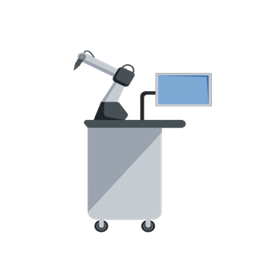

Discovery
November 3, 2018
“Every man has a prostate of a different size and shape.”
If every man’s prostate – like a fingerprint – is different, then why are all prostate biopsies the same?
This is an important question. Picture the map of the U.S., and imagine the shape of Michigan compared to the shape of Maryland. Prostates aren’t that different in size and shape, but every biopsy is done, in effect, as if they were all shaped like Wyoming – with the same basic plan, or template.
“Every man has a prostate of a different size and shape,” says Misop Han, M.D., David Hall McConnell Professor in Urology. “Also, there is a significant movement of the ultrasound probe during the freehand sampling between biopsy cores that can potentially increase discomfort, and also cause inaccurate sampling.”
How can we make biopsies smarter? This is where Dan Stoianovici, Ph.D., Director of the Urology Robotics Program, comes in: As we reported last year in Discovery, Stoianovici designed a novel robotic device, the TRUS Robot, that works through transrectal ultrasound (the imaging used to perform a prostate biopsy). Together, Stoianovici and Han have been working to refine the use of this robot.
They have created a new method to quantify the detection of clinically significant prostate cancer “based on a patient’s own prostate gland size and shape,” Han says. “We believe the TRUS Robot and the new algorithm will improve our ability to detect clinically significant prostate cancer, while decreasing the discomfort for our patients, allowing us to perform a personalized, systematic prostate biopsy.”

